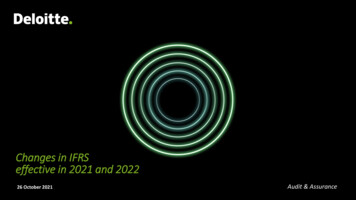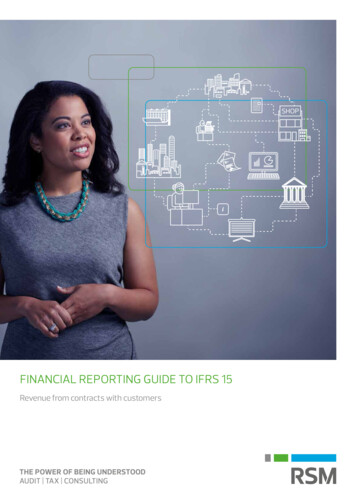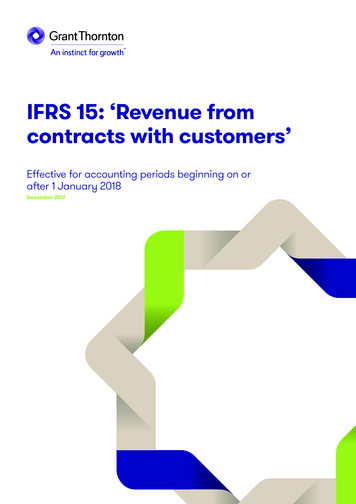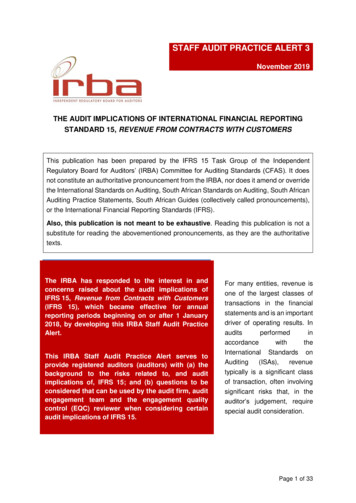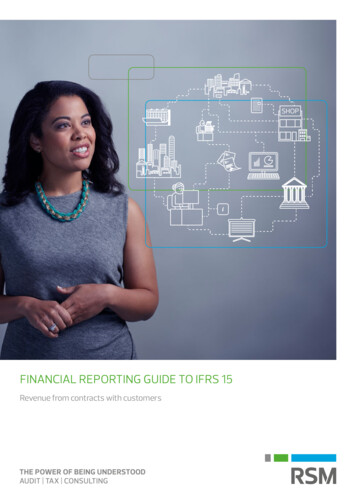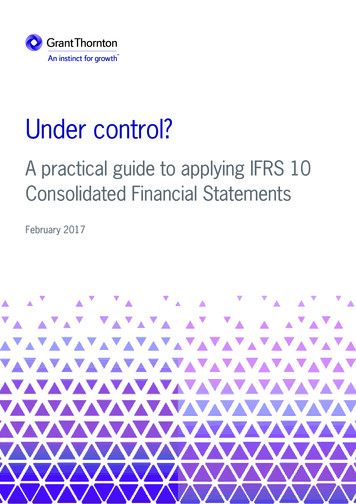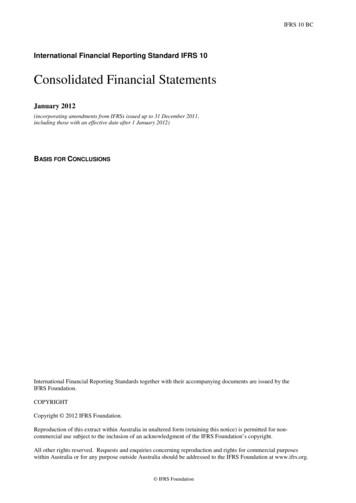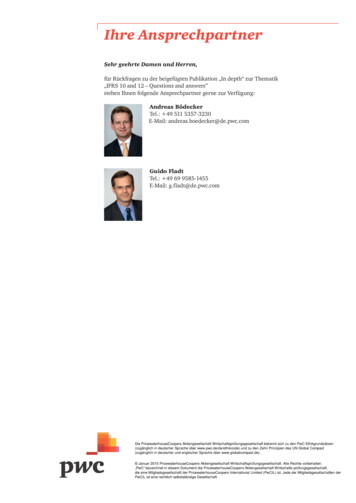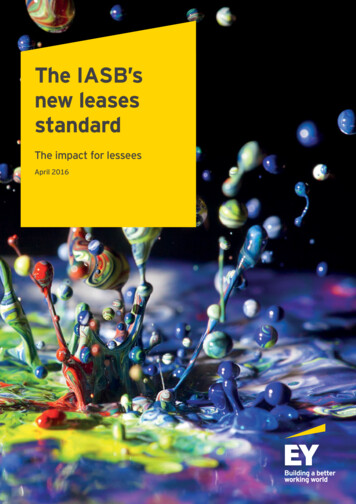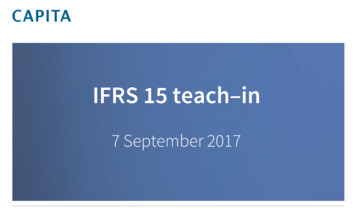
Transcription
IFRS 15 teach–in7 September 2017
AgendaIntroduction Nick GreatorexApplication to Capita David ManuelBreak2016 under IFRS 15 Nick GreatorexKey implications Nick GreatorexNick Greatorex, David ManuelQ&A Simon Mayall, Tory Rogers& Chris Clements2 IFRS 15 teach-in
Introduction IFRS 15 is a significant, complex and far reaching accounting standard Impacts long-term contracts and software licences Closer alignment of our commercial performance with the accounting description Our objectives today Provide you with an understanding of the requirements of the standard Provide an explanation of their application to the Group Provide you with half year and full year 2016 results after application of IFRS 15 Ongoing implications from the adoption of the standardTimeline 7 September: IFRS 15 adoption presentation and release of 2016 financials under IFRS 15 21 September: 2017 half year results under IFRS 15 Early December: pre-close trading statement under IFRS 15, initial views on KPIs 1 March: 2017 full year results under IFRS 153 IFRS 15 teach-in
Early adoption of IFRS 15 Impact due to long-term output based contracts More closely aligns our revenue recognition with commercial substance of contracts Will drive even greater focus on performance across Capita Immediately provides a consistent basis for investors to evaluate our business going forwards In line with our strategy of simplifying the business and improving transparency Consulted widely with advisors, supported by EY and KPMG and their technical teams IFRS 15 adopted in a consistent, prudent and sustainable way4 IFRS 15 teach-in
Key judgements Presents a number of judgements on adoption Transformation packaged with the service as an integrated solution - Capita’s clients value the ‘what’ we dofor them (the delivery of outcomes) rather than the ‘how’ we do it Software products require regular updates, making them a service over time 70% of the Group’s revenue re-profiled Majority of transactional businesses unaffected IFRS 15 realises revenues as outcomes are delivered for clients and therefore increases focus on achievingearly cost efficiencies in contracts to drive profit5 IFRS 15 teach-in
Other important points to note No impact on Capita’s cash flow Changes the way revenue is recognised – a matter of timing Does not change lifetime revenue or profits of contracts New contracts may give rise to losses in early years Profitable long-term contract portfolio continues to drive value for the Group - disclosure of order book Fully retrospective approach - three years of comparative results under IFRS 15 by end 2018 Balance sheet will look very different under IFRS 15 - contract fulfilment assets and significant deferred income We are reviewing remuneration and incentives across the Group and our KPIs Capita Asset Services (CAS) will be treated as a discontinued operation6 IFRS 15 teach-in
IFRS 15 – key pointsNo impact on:Lifetime profitability of contractsCash flow of contractsMajority of transactional businessesKey impacts:Revenue more evenly distributed over the life of contractsand active software licences – timing of profits re-profiledPotentially lower profits or losses in early years oncontracts where there are significant upfront restructuringcosts or higher operating costs prior to transformation –compensating increase in profits in later yearsBalance sheet includes New contract fulfilment assets created in the process oftransforming services Deferred income in relation to contracts wherepayments have been received from clients to undertaketransformation in advance of delivering plannedoutcomes7 IFRS 15 teach-in
IFRS 15 – key points (cont.)Full year 2016 under IFRS 15Underlying continuing*Revenue and operating profit decreased mPre-IFRS 15Net assets moved to net liabilitiesOperating cash unchanged8 IFRS 15 teach-inRevenue mIFRS 154,5824,357Operating profit481335Net assets/(liabilities)483(553)Operating cash750750*Restated to exclude CAS as we will treat it as a discontinued operation at 30 June 2017
Application to CapitaDavid ManuelDirector, Group Finance9 IFRS 15 teach-in
Overview Commercial model Previous accounting policy Example outsourcing contract pre-IFRS 15 The IFRS 15 five step revenue model and application to Capita main impacts areas of no impact Example outsourcing contract post-IFRS 15 Software licence revenue Working capital Presentation and disclosure changes Re-cap of main impacts10 IFRS 15 teach-in
Commercial model – key pointsLarge contracts: We take an inefficient process being run by our client, and transform this into a more efficient and effectivesolution The outcome we strive for is a high quality, efficient solution that addresses our client’s needs, deliveredconsistently over the life of the contract We will often incur greater costs during the transformation stage, particularly if we incur redundancy costs,with costs then diminishing over time as we implement more efficient processes We normally seek to ensure that the cash we receive from our clients reflects the costs we have to incur totransform, restructure and run the service Typically on these contracts the client values the delivery of the transformed service rather than the discretesteps: transform, restructure, and deliverSoftware: Typically specialist software Regular updates and maintenance critical for customer continued usage Customer values the ongoing support and maintenance as much as initial licence11 IFRS 15 teach-in
Previous accounting policy Matching revenue and costs Recognise revenue separately for restructure, transformation and BAU Percentage of completion, common across the sector Higher profits in early years12 IFRS 15 teach-in
Illustrative example - Capita’s outsourcing propositionThroughout this section we will use an example of an outsourcing contract (Contract Saturn) toillustrate the differences between pre-IFRS 15 and post-IFRS 15.Background: Saturn’s in-house function cost 65m p.a. Post-transformation, Capita’s Target Operating Model (TOM) cost 40m p.a. Cost to reach TOM 100m: 10m - restructuring 40m - transformation/technology/transition (including 10m capital expenditure) 50m - operating costs above the TOM prior to the TOM being reachedCapita’s offer to Saturn - 10 year deal: Saturn’s cost to keep function in house 650m Capita’s cost 400m 10m 40m 50m 500m Capita will run the function if Saturn pays Capita 550m Saturn saving 100m Capita profit 50mCash: The profile of the cash received from Saturn matches the profile of Capita’s spend13 IFRS 15 teach-in
Contract Saturn - pre-IFRS 15Transformation phaseBAU phaseAccruedincomeRestructuring 10mContract lifetime profit 50mPre-IFRS 15 revenue 550mCash receivedTarget operatingmodel 40mOperating model at servicecommencement 65m paValueTransformation 30mOperating costsTime14 IFRS 15 teach-in
Contract Saturn - pre-IFRS 15 (cont.) Prior revenue recognition policy matched costs and revenue – percentage of completion The revenue in the chart matched the cost profile Yellow area represented profit The Group earned higher profits during the complex transformation phase Followed by normalised margins in the Business As Usual (BAU) phase Accrued and deferred income was the difference between cash receipts and revenue recognition15 IFRS 15 teach-in
Contract Saturn - IFRS 15BAU phaseTransformationphaseContract lifetime profit 50mIFRS 15 revenue 550mCash receivedInitial lossDeferred incomeFixed asset depreciation and contract fulfillment asset utilisation 40mTarget operating model 40mOperating model at servicecommencement 65m paValueRestructuring 10mTime16 IFRS 15 teach-inOperating costs
IFRS 15 - main impacts for Capita Revenue: recognition of revenue over the life of major contracts and active software licences spread moreevenly Costs: certain transformation spend, previously expensed, now capitalised as contract fulfilment assetsand released over the contract life. Redundancies expensed upfront. Increased focus on cost reduction Profit: phasing of profits on major contracts may be shaped differently, with potentially lower profits orlosses in the early years on contracts – but overall contract profitability unchanged – just the timing Balance sheet: net liabilities reflects increase in deferred income on contracts where we have been paidto undertake transformation prior to delivering planned outcomes for clients Presentation: underlying result further analysed to separately disclose results of significant new contractwins and restructuring Cash: no change17 IFRS 15 teach-in
IFRS 15 – a five step revenue model IFRS 15 provides a framework that replaces existing revenue guidance in US GAAP and IFRS The five step model is to be used for all revenue in all industries The five step model will determine when to recognise revenue, and at what amount, once an entity transferscontrol of goods or services to a customer Steps 2 and 5 have the biggest impact for Capita New qualitative and quantitative disclosure requirements aim to enable investors increased clarityStep 1Step 2Step 3Step 4Step 5Identify the“IFRS ne thetransactionpriceAllocate thetransactionpriceRecogniserevenue18 IFRS 15 teach-in
Step 1 – Identify the “IFRS 15 contract”An “IFRS 15 contract” broader than just legalagreements such as frameworks, contracts and sideletters so that the combined agreement meets thefollowing criteria:1.Parties approved the contract, and arecommitted to perform the obligations2.Rights of parties identified3.Payment terms established4.Contract has commercial substance5.Collection of consideration is probable19 IFRS 15 teach-inApplication to Capita:Trading businesses – no difference as eachstandalone transaction meets the five step criteriaSoftware businesses – can result in separatelicence and maintenance agreements being bundledinto a single “IFRS 15 contract”Frameworks – some framework agreements will notmeet the definition of a single “IFRS 15 contract”and instead individual calls-offs treated as separatecontracts
Step 2 – Identify performance obligationsIdentify the promisesA promise is an implicit or explicit commitment made byyou to your customer within the “IFRS 15 contract”identified in Step 1Identify the Performance ObligationsThe individual promises are grouped together until theycombine to make a distinct good or service. IFRS 15calls these groupings of promises performanceobligationsTo be distinct the performance obligations must beboth: Capable of being distinct Distinct within the context of the contract20 IFRS 15 teach-inApplication to Capita:Requirement to consider what the distinct performanceobligations are for each contractThe core service: DistinctCore service provides functions previously provided an inhouse departmentTransformation: Not distinct, combined with core serviceTransformation is a significant element in meeting the coreperformance obligations of delivering an efficient service forthe customerRestructuring – Not distinct, combined with core serviceThe benefit to the customer of Capita’s restructuring spendis the more efficient service Capita delivers posttransformation
Step 2 – Identify performance obligations (cont.)Contract fulfilment assetApplication to Capita:Costs of fulfilling a contract that cannot becapitalised under another standard are capitalised ifthey:The Group will capitalise investment in the IP of thebusiness solution that achieves the target operatingmodel and generates value in terms of the expertiseused to deliver an efficient high quality service in thefuture1. Relate directly to a contract;2. Generate or enhance resources that will be usedto satisfy performance obligations in the future;and3. Are expected to be recoveredThis is separate, and in addition to, the traditionaltangible and intangible assets that may be createdon the set-up of a contract. Consistent with anyother assets, the CFA are subject to impairmenttestingThe release of contract fulfilment assets occur oncethe enhanced resource is being usedExamplesThe release is spread over the useful economic life ofthe enhanced resourceRefer to appendix for specific contract fulfilmentasset examples21 IFRS 15 teach-in
Step 3 & 4 – Determine and allocate the transaction priceAllocation of the transaction priceThis step has two goals:Determine transaction priceIFRS 15 introduces the concept of transaction priceThe transaction price is the amount of consideration to which an entityexpects to be entitled in exchange for transferring goods or services to acustomerAn entity estimates the transaction price at contract inception andupdates the estimate each reporting period for any changes incircumstances1. ensure appropriate revenue allocation between performanceobligations2. allow revenue to be allocated to unpriced performanceobligationsIFRS 15 requires allocation of the total transaction pricebetween the performance obligations based on relativeStandalone Selling Price (SSP)Application to CapitaSSP is IFRS 15’s definition of a fair price for each performanceobligation and is based on an arms length selling price for thatperformance obligation assuming none of the other obligationsexistedDisclosuresApplication to CapitaThe disclosure requirements include reporting the currently contractedfuture revenuesMost performance obligations in the Group’s contracts do notmeet the definition of being distinct, and so there are fewperformance obligations to allocate the transaction priceRevenue to date must be highly probably not to reverseOn a contract basis IFRS 15 insists that at all times the total revenuerecognised to date is highly probably not to reverse, this leads to theGroup to restrict revenue recognition on some gain-share arrangementsas compared to previous accounting22 IFRS 15 teach-inWhere price step downs are included in the life of a contract, butwith no change to the underlying scope of services delivered,these step downs are included in the transaction price andallocated to the relevant performance obligation
Step 5 – Recognise revenueOver time vs point in timeTo be over time a service must meet one of the following conditions: Entity creates or enhances an asset that the customer controls as it is created or enhanced Entity’s performance does not create an asset with alternative use and the entity has an enforceable right to payment forperformance completed to date Client simultaneously receives and consumes the benefits of the entity’s performance as the entity performs and anotherentity would not have to re-perform work completed to dateInput vs OutputFor an over time service you have to decide what is the most appropriate measure of progress: Input – value is transferred to the client based on how we do the service Output – value is transferred to the client based on what we do for themA series of over time servicesWhen considering application of the series provision within IFRS 15, the FASB and IASB’s Joint Transition Resource Groupspecifically use the example of an outsourcing arrangement for reference.23 IFRS 15 teach-in
Step 5 – Recognise revenue (cont.)Application to Capita:As the client benefits from the more efficient Capita service throughout the contract Capita’s revenue will berecognised over timeThe value to Capita’s clients is not based on how Capita delivers the service, but on what service Capita deliversIn applying IFRS 15 Capita has therefore adopted the output method, and applied the series guidance, as theunderlying principleThe dynamics of an output driven revenue stream Revenue varies by output volume The same output item has the same revenue value throughout the contract As revenue per output item is fixed, in year profitability improves as we become more efficient and lower thecost to deliver24 IFRS 15 teach-in
Contract Saturn - IFRS 15TransformationphaseBAU phaseContract lifetime profit 50mIFRS 15 revenue 550mCash receivedInitial lossDeferred incomeFixed asset depreciation and contract fulfillment asset utilisation 40mTarget operating model 40mOperating model at servicecommencement 65m paValueRestructuring 10mTime25 IFRS 15 teach-inOperating costs
Contract Saturn - IFRS 15 (cont.) IFRS 15 revenue more evenly spread following the IFRS 15 series guidance and outputmethod of recognition with a single performance obligation (green line) Operating costs unchanged (dark blue) Fixed asset depreciation and contract fulfilment cost utilisation spread over the contractlifetime (red) Restructuring costs expensed with no related revenues (light purple) Total profit unchanged, but profile over the contract lifetime different (yellow) Results in lower profits or losses (orange) in early stage of long term contracts Cash received unchanged (blue line) Increased deferred income as cumulative cash receipts greater than cumulative revenuerecognised26 IFRS 15 teach-in
Software licencesPre IFRS 15:Perpetual licences: the revenue is recognised as a point in time when the licence legally transfers to the customer; orTerm licences: the revenue is spread over the term of the licence.IFRS 15:Active licences – a right to access: licences which require continuous upgrade and updates for the software to remainuseful, and the revenue is recognised over the life of the licence; orPassive licences – a right to use: all other licences are treated as passive licencesSoftware as a service (SaaS)Pre IFRS 15: The revenue is recognised over the service.IFRS 15: Accounting for SaaS is unchangedApplication to Capita:The Group has concluded that most of its software licences are “active” and as such are spread over the life of thecontract27 IFRS 15 teach-in
Illustrative example - Capita’s software propositionThroughout this section we will use an example of a software licence (Neptune) to illustrate thedifferences between pre-IFRS 15 and post-IFRS 15.Background: Neptune is a B2B sale of a perpetual software licence for operationally critical systems Price breakdown 25m: 10m – perpetual licence 10m – implementation and adaptation 5m - 1m per annum maintenance revenue over a 5 year maintenance term Cost breakdown 12m: No incremental costs – perpetual licence in a sunk cost as it is a copy of an existing softwareproduct 8m – implementation and adaptation 4m – allocation of maintenance team costs28 IFRS 15 teach-in
Software - contract level analysisTypical Softwarecontract – Pre-IFRS 15accountingTypical Softwarecontract - IFRS 15accountingGo-live dateGo-live dateContract inceptionContract endContract inceptionGross profit}CostContract endMaintenance revenueInstallation revenueMaintenance revenueInstallation revenueMaintenance cost(expensed in-period)Installation cost(expensed in-period)Maintenance cost(expensed in-period)Installation cost(expensed in-period)Licence revenueCashLicence revenueCash29 IFRS 15 teach-in}
Illustrative working capital cyclePre-IFRS 152016UnaffectedincomeIncome deferred(cash received in2016)Income broughtforward (cashreceived 2015)IFRS 152016UnaffectedincomeIncome deferred(cash received in2017)Income broughtforward (cashreceived 2016)IFRS 152017Unaffectedincome2015201830 IFRS 15 teach-in
Presentation of underlying operating profit New presentation of the in year profits/losses from significant new contract wins and related, or significant,restructuring. Provides greater transparency of performance Underlying operating profit reported at the half year and full year to be analysed into “Underlying beforesignificant new contracts and restructuring” and “Significant new contracts and restructuring” Future guidance to be provided based on “Underlying before significant new contracts and restructuring” Announcement of significant new contract wins will include the forecast: profits/losses in that year,restructuring costs, and inflection point. In year impact will be reported in “Significant new contracts andrestructuring” Presented as a new note to the financial statements31 IFRS 15 teach-in
IFRS 15 – re-cap of main impacts for Capita Revenue: recognition of revenue over the life of major contracts and active software licences spread moreevenly Costs: certain transformation spend, previously expensed, now capitalised as contract fulfilment assets andreleased over the contract life. Redundancies expensed upfront. Increased focus on cost reduction Profit: phasing of profits on major contracts may be shaped differently, with potentially lower profits orlosses in the early years on contracts – but overall lifetime contract profitability unchanged – just the timing Balance sheet: net liabilities reflects increase in deferred income on contracts where we have been paid toundertake transformation prior to delivering planned outcomes for clients Presentation: underlying result further analysed to separately disclose results of significant new contractwins and restructuring Cash: no change32 IFRS 15 teach-in
2016 Results under IFRS 15Nick GreatorexGroup Finance Director33 IFRS 15 teach-in
Underlying results excluding discontinued operationsCapita Asset Services (discontinuedoperations)As reported in 2016Pre-IFRS 15 continuing operations mSixmonthsendedJune 2016* mSixmonthsendedDecember2016* mYearendedDecember2016* mSixmonthsendedJune 2016* mSixmonthsendedDecember2016* mYearendedDecember2016* mSixmonthsendedJune 2016* mSixmonthsendedDecember2016* 582,3244,582Operating ---(32)(34)(66)Profit before tax285190475283260257158415Profit attributableto shareholders227150377232851204122326Basic eps evenueAll following slides have been restated under IFRS 15 for the impact of discontinued operations34 IFRS 15 teach-in*Excludes specific items which include: intangible amortisation, impairments, net contingentconsideration movements, other non-recurring items, non-cash mark to market finance costs
Underlying income statementPre-IFRS 15 mSix monthsended June2016*Revenue mSix monthsendedDecember2016*IFRS 15 mYear endedDecember2016* mSix monthsended June2016* mSix monthsendedDecember2016* mYear erating 4)(66)Profit before tax257158415134135269Profit attributable 1215.5631.68Basic eps (pence)35 IFRS 15 teach-in*Excludes specific items which include: intangible amortisation, impairments, net contingent consideration movements, other nonrecurring items, non-cash mark to market finance costsAll Pre-IFRS 15 are based on discontinued operations
Underlying revenuePre-IFRS 15 mSix monthsended June2016*Total reported revenueIFRS 15 mSix monthsendedDecember2016* mYear endedDecember2016* mSix monthsended June2016* mSix monthsendedDecember2016* mYear 2,2264,3572015 acquisitions(67)(9)(76)(67)(9)(76)2016 42,0522,1814,233Available for sale in 2015,disposed in 20162016 disposalsRevenue from continuingactivitiesOrganic revenue on continuingbasis36 IFRS 15 teach-in*Like-for-like revenue growth includes a justice business which was previously held for sale in 2015, on which the disposal process ceased and was movedback into underlying reported revenue in 2016
Underlying revenue bridge – FY 2016Non-recurring itemsRecurring 22,0004,3571,0002016 Underlying Revenue37 IFRS 15 teach-inBrought forward from prior Carried forward to next yearyearAgent vs Principal2016 Revenue restated
Underlying operating profitSix months ended 30 June 2016Underlyingbeforesignificant newcontracts andrestructuringRevenueCost of salesGross profitAdministrative expensesOperating profitSignificant newcontracts andrestructuringYear ended 31 December 2016 mTotalunderlying*Underlyingbeforesignificant newcontracts andrestructuringSignificant newcontracts andrestructuring 59)(604)166-166394(59)335As part of the transition to IFRS 15 we have included the 2016 59m restructuring provision in underlying profit38 IFRS 15 teach-in*Excludes specific items which include: intangible amortisation, impairments, net contingent consideration movements, other non-recurring items, noncash mark to market finance costs
Underlying PBT bridge H1 2016Non-recurring itemsRecurring 34502016 H1 Pre-IFRS Active Licences - Networks PoC - Accrued Income15 PBTDSS*PiT*reduction as not"highlyprobable"*39 IFRS 15 teach-inPricesmoothing*TransformationContractcosts expensed* modification**These movements taken together are as a result of the impact on revenue of the application of IFRS 15Other*2016 H1 PBTrestated
Underlying PBT bridge H2 2016Non-recurring itemsRecurring 58135604020-2016 H2 Pre-IFRS Active Licences - Networks PoC - Accrued Income Price smoothing* Transformation15 PBTDSS*PiT*reduction as notcosts expensed*"highlyprobable"*40 IFRS 15 teach-inContractmodification**These movements taken together are as a result of the impact on revenue of the application of IFRS 15Accrued income Restructuringwrite backprovisions2016 H2 PBTrestated
Underlying PBT bridge FY 2016Non-recurring itemsRecurring 20041515026910050-2016 FY Pre- Active Licences Networks PoC IFRS 15 PBT- DSS*PiT*41 IFRS 15 teach-inAccruedIncomereduction asnot ing*costsmodification*expensed**These movements taken together are as a result of the impact on revenue of the application of IFRS 15Accruedincomewrite backRestructuringprovisionsOther*2016 FY PBTrestated
Full year 2016 underlying operating profit bridgeto reported operating profit – old GAAP ex CASNon-recurring itemsRecurring itemsNon-cash ngoperatingprofitExceptional Contract asset Impairmentsrestructuring write-down of goodwill &expenseacquiredintangibles42 IFRS 15 teach-inCo-opAmortisation Asset Services Acquisition Business gprofit
Full year 2016 underlying operating profit bridgeto reported operating profit under IFRS 15Non-recurring itemsRecurring items500Co-Op: charge arising fromcontract dispute increasesfrom 18m to 53m due to derecognition of contractfulfilment assetNon-cash items400(58)300200 m335Restructuringexpense: 59mmoved tional Contract asset Impairments ofoperating profit restructuringwrite-downgoodwill &(restated forexpenseacquired-100IFRS 15)intangibles43 IFRS 15 teach-inCo-op(9)3Amortisation Asset Servicessettlement Acquisition cost Business exitsprovision(6)Other(30)Reportedoperating profit(restated forIFRS 15)
Overall Group revenue split 2016Revenue split - Pre-IFRS 15Revenue split - IFRS 1516%Short term contractual & trading39%61%16%Long term contractual68% Pre-IFRS revenue split between ‘shortterm contractual & trading’ and ‘longterm contractual’ Under IFRS 15, revenue split between‘contract length 2 years’, ‘contractlength 2 years’ and ‘transactional(point in time)’44 IFRS 15 teach-inTransactionalContractual 2 yearsContractual 2 years On the following pages, allocation ofcorporate overheads to each divisionhave been revised to be comparable tothe 2017 results being reported on 21September
Private Sector Partnerships Key movements:FY16Pre-IFRS 15 The effect of price step downs being converted into anIFRS 15 blended revenue in CM and Insurance 2016 accrued income impairment reversedRevenue CFA write downProfitMarginRevenue split - Pre-IFRS 15 1,568m 1,544m 108m 122m6.9%7.9%Revenue split - IFRS 155%13%FY16IFRS 1518%Short term contractual & tradingTransactionalContractual 2 years87%45 IFRS 15 teach-inLong term contractual77%Contractual 2 yearsFY16 pre-IFRS 15 comparatives based on continuing activities before the write down of accrued incomeNote: All figures prior to allocation of overheads
Public Services Partnerships Key movements:FY16Pre-IFRS 15 Effect of change to highly probable recognition on gainshare Transformation phase on PCSERevenue 2016 accrued income impairment reversed 1,208m 1,124mProfit 88m 9mMargin7.3%0.8%Revenue split - IFRS 15Revenue split - Pre-IFRS 1512%21%46 IFRS 15 teach-inTransactional18%Short term contractual & tradingLong term contractual79%FY16IFRS 1570%Contractual 2 yearsContractual 2 yearsFY16 pre-IFRS 15 comparatives based on continuing activities before the write down of accrued incomeNote: All figures prior to allocation of overheads
Professional Services Key movements:FY16Pre-IFRS 15 The effect of moving from percentage on completionaccounting to revenue which varies with output Move from agency to principal accounting treatmentin Learning ServicesRevenue split - Pre-IFRS 15FY16IFRS 15Revenue 676m 717mProfit 127m 115mMargin18.8%16.0%Revenue split - IFRS 15Transactional32%24%Short term contractual & trading76%47 IFRS 15 teach-inContractual 2 years57%Long term contractual11%Contractual 2 yearsFY16 pre-IFRS 15 comparatives based on continuing activities before the write down of accrued incomeNote: All figures prior to allocation of overheads
Digital & Software Solutions Key movement:FY16Pre-IFRS 15 Net impact of active licences being spread over timeRevenue split - Pre-IFRS 15Revenue 436m 420mProfit 145m 136mMargin33.3%3
Jan 01, 2017 · IFRS 15 –key points (cont.) 8 IFRS 15 teach-in Underlying continuing* m Pre-IFRS 15 m IFRS 15 Revenue 4,582 4,357 Operating profit 481 335 Net assets/(liabilities) 483 (553) Operating cash 750 750 Full year 2016 under IFRS 15 Revenue and operating profit decreased Net

